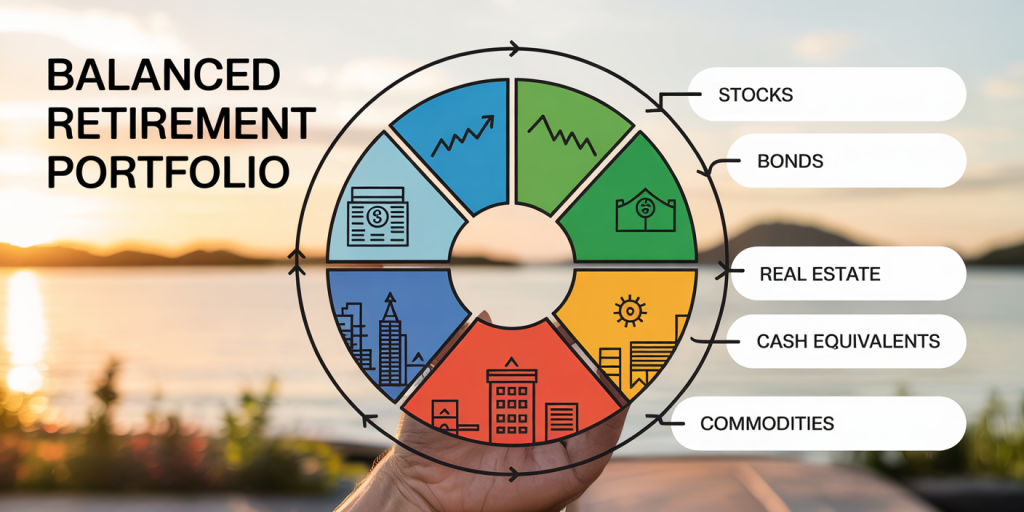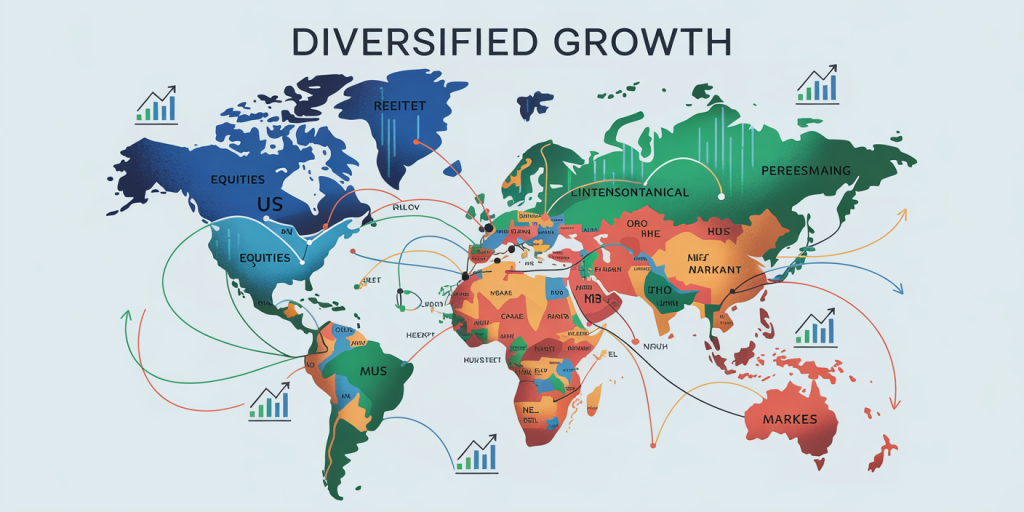The Importance of Diversification in Your Retirement Portfolio
Anúncios
Planning for retirement is one of the most critical financial steps an individual can take. A well-crafted retirement portfolio aims to provide financial security and stability when regular income from employment ceases. However, investing in a single asset class or sector can expose retirees to risks that might erode their savings and jeopardize their future. Diversification, as an investment strategy, helps mitigate such risks by spreading investments across various asset classes, industries, and geographies. This article highlights the importance of diversification in retirement portfolios, providing data-backed insights, practical examples, and comparative analyses to demonstrate how diversification can contribute to long-term financial health.
Why Diversification Matters in Retirement Investing
Diversification’s fundamental purpose is to reduce risk without necessarily sacrificing returns. When you diversify your investments, the poor performance of one asset is often offset by the better performance of another, keeping the overall portfolio more stable. This balance is particularly crucial for retirees, who may not have the luxury of time to recover from significant investment losses.
Anúncios
A practical example can be seen in the 2008 financial crisis when the stock market plunged approximately 37% (S&P 500 decline). Investors heavily concentrated in equities suffered tremendous losses that impacted their retirement savings. Conversely, those with diversified portfolios including bonds, real estate investment trusts (REITs), and cash equivalents experienced less severe downturns. According to a Vanguard study, a portfolio diversified across stocks, bonds, and other asset classes in 2008 saw an overall loss of approximately 15%, significantly less than the equity-heavy portfolios. This difference illustrates how diversification can shield retirees from market volatility.

Anúncios
Moreover, the concept of the “sequence of returns risk” is a significant concern for retirees who are beginning to withdraw funds from their portfolios. Poor investment returns early in retirement can severely deplete capital, forcing reduced spending or increased risk-taking. A diversified portfolio can alleviate this risk by smoothing out the downturns, offering more consistent income streams over time.
Asset Classes and Their Role in Reducing Portfolio Volatility
An effective diversification strategy begins with understanding the major asset classes: equities (stocks), fixed income (bonds), cash equivalents, real estate, and alternative investments such as commodities or hedge funds. Each has a unique risk-return profile that behaves differently depending on the economic environment.
Stocks generally offer higher returns but come with increased volatility. Bonds, on the other hand, usually provide steady income with lower risk. Real estate tends to have low correlation with stocks and bonds and can provide both income and capital appreciation. Cash equivalents are the safest but offer minimal returns. Alternative investments can enhance returns and offer further diversification benefits but may carry higher risks or costs.
For retirement portfolios, a common rule of thumb is the “age-in-bonds” approach, where the percentage of bonds equals the investor’s age, with the remainder in stocks. For instance, a 65-year-old might hold 65% in bonds and 35% in stocks. However, the right mix varies based on risk tolerance, retirement goals, and other income sources.
Comparative Table: Risk and Average Annual Returns by Asset Class (Past 20 Years)
| Asset Class | Average Annual Return (%) | Standard Deviation (Risk) (%) | Correlation with Stocks |
|---|---|---|---|
| Large-Cap Stocks | 8.5 | 15.0 | 1.0 |
| Bonds (US Treasuries) | 4.0 | 5.0 | 0.2 |
| Real Estate (REITs) | 7.0 | 12.0 | 0.5 |
| Cash Equivalents | 1.5 | 0.5 | 0.0 |
| Commodities | 5.0 | 20.0 | 0.3 |
*Sources: Morningstar, 2023*
The table above shows how incorporating bonds and real estate can significantly decrease portfolio volatility while maintaining reasonable returns. Retirees can use this information to build a balance that fits their comfort level.
Diversification Across Geographic Regions
Another dimension of diversification is geographic allocation. Many investors limit themselves to domestic markets, which can be risky if the local economy suffers. Global diversification exposes portfolios to various economic cycles and growth opportunities worldwide, reducing reliance on any one country’s financial health.

Take, for example, the Japanese asset price bubble burst in the early 1990s, which led Japan’s stock market to stagnate for decades. Investors with all their retirement funds vested in Japanese stocks would have experienced poor returns. Alternatively, international diversification, including emerging markets or developed economies like the US and Europe, offers higher potential for growth albeit with different risk profiles.
According to MSCI data, emerging markets provided an average return of around 10% from 2000 to 2020 compared to 6-7% for developed markets. Including a portion of emerging market stocks can enhance returns but demands tolerance for short-term volatility. On the other hand, developed international markets often correlate differently with domestic markets, providing smoother portfolio experience.
Practical Example: Geographic Diversification Impact
An investor with 100% US equities portfolio from 2000-2020 would have earned an average return near 6%. However, an investor with 60% US equities, 30% international developed markets, and 10% emerging markets achieved approximately 8%, showing how diversification can boost returns.
Incorporating Different Investment Styles: Growth vs. Value and Active vs. Passive
Diversity in portfolio management styles is also critical. Growth stocks emphasize companies expected to increase earnings significantly, while value stocks focus on undervalued firms with potential for recovery. Over time, these investment styles tend to perform differently depending on market cycles.
Examining real-world data, value stocks outperformed growth stocks during market recoveries like after the 2008 crash, while growth stocks led during tech booms such as in the late 2010s. Retirees can balance growth with value components to lessen the effects of market swings.
Additionally, the choice between active and passive investment strategies can enhance diversification. Passive investing—tracking market indexes—provides broad market exposure at low costs, while active management seeks to capitalize on inefficiencies for higher returns. Combining both can improve the risk-return profile.
Real-Life Case Study: The 2020 COVID-19 Market Crash and Recovery
The COVID-19 pandemic created an unprecedented market shock in early 2020, with global indices plunging over 30% in a month. Investors with undiversified portfolios heavily weighted towards certain sectors such as hospitality or energy faced steep losses. By contrast, those diversified across technology stocks, bonds, and other alternatives saw less dramatic drops.

For instance, the S&P 500 lost approximately 34% from February to March 2020, while US Treasury bonds yielded positive returns of about 3% during the same period, acting as a safety net for conservative portfolios. This diversification allowed retirees to maintain financial stability amid chaos.
Moreover, adding alternative assets like gold, which rose by nearly 14% in 2020, contributed to portfolio resilience. This case vividly illustrates the role of diversification in safeguarding retirement savings during crises.
Common Mistakes to Avoid in Diversification
While diversification is essential, investors must avoid common pitfalls that undermine its benefits. One typical mistake is overdiversification, where portfolios include too many overlapping investments, leading to unnecessarily complex portfolios that dilute returns without reducing risk further.
Similarly, simply holding many funds without considering their correlation can give a false sense of security. For instance, multiple funds holding the same large-cap stocks provide little diversification benefit. Retirees should analyze portfolio holdings to ensure genuine diversification.
Another error is neglecting periodic portfolio rebalancing. Market fluctuations cause asset weightings to deviate from original targets, potentially increasing exposure to riskier assets. Rebalancing involves adjusting allocations back to intended proportions, maintaining the desired risk profile.
Looking Ahead: The Future of Retirement Portfolio Diversification
In the evolving world of finance, diversification strategies continue to adapt. Advances in technology and data analytics now empower investors with more precise risk assessments and asset allocation models tailored to individual needs. Artificial intelligence-driven robo-advisors have democratized access to diversified portfolios based on personal goals and risk tolerance.
Environmental, social, and governance (ESG) investing is gaining traction, representing another diversification layer. Integrating ESG criteria can mitigate long-term risks related to regulatory changes and corporate sustainability, potentially enhancing portfolio resilience.
Moreover, innovative asset classes such as cryptocurrency are beginning to enter the diversification conversation. While still highly volatile and speculative, small allocations in digital assets could offer uncorrelated returns. However, cautious investors, especially retirees, should approach these with thorough research and defined risk parameters.
Demographic trends also shape retirement planning. With increasing life expectancy, retirees require portfolios that support longer drawdown periods, necessitating diversification strategies that balance growth, income, and capital preservation with evolving market conditions.



Post Comment